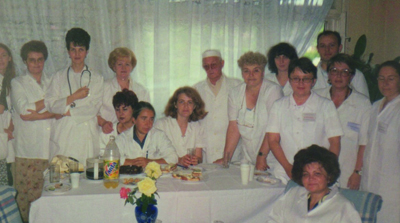Fall (Volume 28, Number 3)
Rheumatology Practice on Both Sides of the Pond
By Brandusa Florica, MD, PhD, FRCPC
Download PDF
When I look back and try to compare the two periods of my life, I realize that it can only be done through the eye of my experience and my present way of thinking. I was very happy to start a residency in rheumatology and then to practice as a rheumatologist some years ago, when I finished my university degree in medicine in Romania. Before pursuing rheumatology, my alternatives were either to start off a surgery program, for which I did not feel any calling, or to work as a general practitioner in a remote place of the country, with minimal access to any investigative tools and minimal treatment options. My interest in rheumatology is linked to my inclination towards detective work, and the need for professional satisfaction from helping suffering people, as well as to my first medical mentor, who is a great personal and professional role model.
What was it like to work as a rheumatologist in Romania? There were, as you might expect, many similarities and many differences to working in Canada. I was surrounded by many enthusiastic rheumatologists who had very good knowledge and clinical practice experience. I worked with in-patients in a hospital setting and also with out-patients in a clinic within the same hospital. The pathology was similar: there were many patients with rheumatoid arthritis (RA), inflammatory spondyloarthritis, and osteoarthritis (OA), but we also saw the full breadth of other rheumatic diseases. My impression was that Romanian patients suffered from more severe forms of inflammatory arthritis (IA), with many related disabilities and more significant impact on their quality of life; however, these observations stem from work in a tertiary referral center 15 years ago, when early diagnosis and newer treatment options were relatively less available. Romania, an eastern European country, had a relatively poor health-care system, so diagnostic tools were limited. The positive aspect of that situation was that it provided the stimulus for medical doctors to become more attentive to clinical examination and develop useful clinical skills. I always admired the ability of my teachers to diagnose a condition based only on a detailed clinical examination and a focused history.

Rheumatology group, led by Professor Rodica Chireac, at the University of Medicine in lași, Romania, 2002.
As opposed to a practice-based mainly on skillful interview and physical examination of the patient, the rheumatology practice I observed in Canada relied much more frequently on available investigative data. This is a practice driven by patient requests, and also by the need to document investigational findings as part of the qualification criteria for diagnosis or treatment imposed by governmental and non-governmental insurance programs. This gives the doctor only partial liberty to be creative and adapt to the specific condition of the patient, to challenge his/her diagnostic skills, or to try different treatment options. In other words, there was more opportunity for a “cowboy”-type medicine practice in Romania. Of course, each of these two types of practices has pros and cons. A standardized, guideline-based diagnosis and treatment of a medical condition is a far safer way of practicing medicine.
Another difference between the practice of rheumatology in Canada and Romania is in the doctor-patient relationship. Such interaction between a patient with a chronic disease and a rheumatologist is based on respect, trust and confidence wherever you are on earth. However, the initial patient-rheumatologist interaction in Canada is more frequently critically scrutinized by the patient. The physician may be considered a mere service provider, who may even be under-qualified compared to “Dr. Google”, as perceived by the patient. It takes good skills and dedicated time to develop a trust-based relationship, which is highly beneficial for effective treatment. In Romania, the physician is usually perceived as a highly qualified individual who is able to decide what is best for the patient, and provide the best advice in his field of expertise, without being challenged by the patient. This is based on a more traditional, paternalistic approach in the relationship between patient and physician.
At the same time, a Canadian physician has the advantage of exposure to a diversity of rheumatologic diseases, and also to the different cultural attitudes to diseases. To be able to understand the real meaning of different patients’ behaviours, one needs to learn more about their specific culture and customs. I cannot forget an episode when I was amazed by one of my patients’ reaction to bad news. He was an elderly person, originally from China, who was smiling continuously during our interview, despite the fact that I told him that he had developed a terminal condition. My first impression was that he did not understand my message; I found out later on that, in his own culture, a proud person should not show their real feelings on his or her face.
Despite some differences of practicing medicine in different areas of the world, the real reward for a rheumatologist is to be valued by the patients for the difference that they made in their quality of life. I remember with pleasure a thank you letter I received from a Romanian patient, after a period of treatment for RA. She was very happy to be able to write it with her newly recuperated hand. The hugging and the happiness of my Canadian patients is what helps keep me going through a long day of consults.
Overall, I feel blessed and honoured to be part of the community of rheumatology professionals in Canada, and to share the enthusiasm of practicing during this exciting time for our specialty.

At the 1996 National Romanian Conference of Rheumatology in lași.
Brandusa Florica, MD, PhD, FRCPC
Lecturer, Division of Rheumatology,
Department of Medicine,
University of Toronto
Rheumatologist,
Trillium Health Partners
Mississauga, Ontario
|
